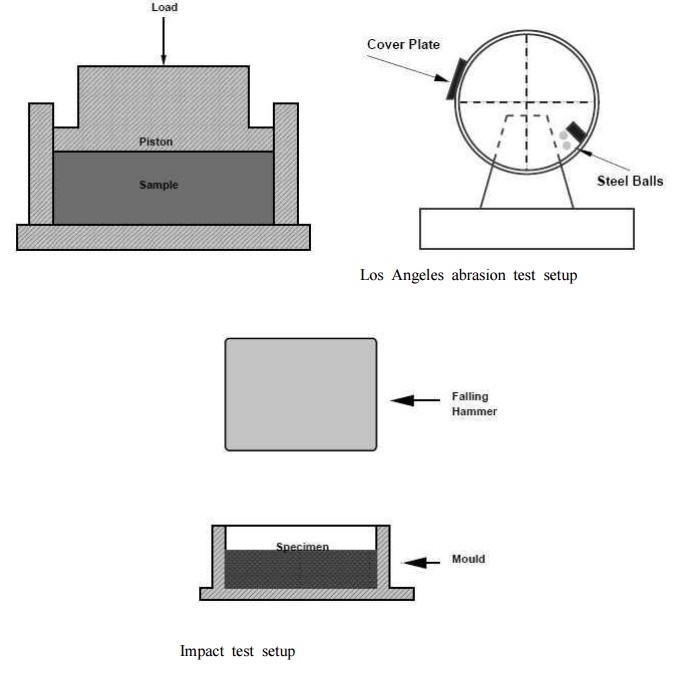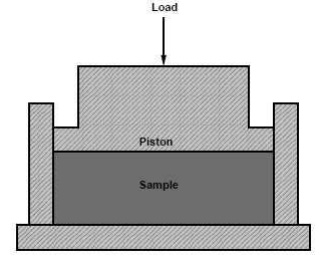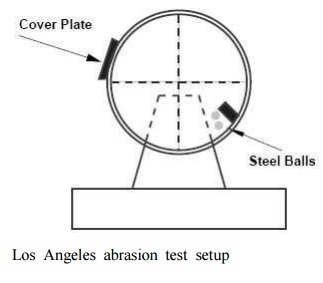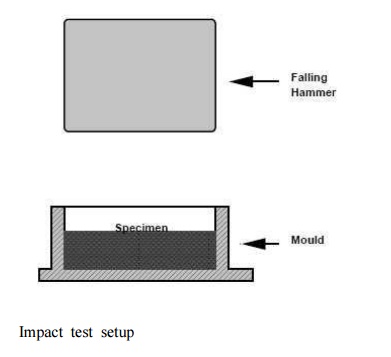Chapter: Civil : Highway Planning and Alignment : Highway Construction Materials And Practice
Highway Construction: Tests on soil

Tests on soil
Sub grade soil is an integral part of the road pavement
structure as it provides the support to the pavement from beneath. The sub
grade soil and its properties are important in the design of pavement
structure. The main function of the sub grade is to give adequate support to
the pavement and for this the sub grade should possess sufficient stability
under adverse climatic and loading conditions. Therefore, it is very essential
to evaluate the sub grade by conducting tests.
The tests used to evaluate the strength properties of soils
may be broadly divided into three groups:
Shear
tests Bearing tests Penetration tests
Shear tests are usually carried out on relatively small soil
samples in the laboratory. In order to find out the strength properties of
soil, a number of representative samples from different locations are tested.
Some of the commonly known shear tests are direct shear test, triaxial
compression test, and unconfined compression test.
Bearing tests are loading tests carried out on sub
grade soils in-situ with a load bearing area. The results of the bearing tests
are influenced by variations in the soil properties within the stressed soil
mass underneath and hence the overall stability of the part of the soil mass
stressed could be studied.
Penetration
tests may be considered as small scale bearing tests in which the size of the
loaded area is relatively much smaller and ratio of the penetration to the size
of the loaded area is much greater than the ratios in bearing tests. The
penetration tests are carried out in the field or in the laboratory.
1.Crushing
test
One of the model in which pavement material can fail is by
crushing under compressive 52 stress. A test is standardized by IS:2386 part-IV
and used to determine the crushing strength of aggregates. The aggregate
crushing value provides a relative measure of resistance to crushing under
gradually applied crushing load. The test consists of subjecting the specimen
of aggregate in standard mould to a compression test under standard load
conditions (Figure 22:1). Dry aggregates passing through 12.5 mm sieves and
retained 10 mm sieves are filled in a cylindrical measure of 11.5 mm diameter
and 18 cm height in three layers. Each layer is tampered 25 times with at standard
tamping rod. The test sample is weighed and placed in the test cylinder in
three layers each layer being tampered again. The specimen is subjected to a
compressive load of 40 tonnes gradually applied at the rate of 4 tonnes per
minute. Then crushed aggregates are then sieved through 2.36 mm sieve and
weight of passing material (W2 ) is expressed as percentage of the weight of
the total sample (W1 ) which is the aggregate crushing value.
Aggregate crushing value = W1x100 W2

A value less than 10 signifies an exceptionally
strong aggregate while above 35 would normally be regarded as weak aggregates.
2
Abrasion test
Abrasion test is carried out to test the hardness
property of aggregates and to decide whether they are suitable for different
pavement construction works. Los Angeles abrasion test is a preferred one for
carrying out the hardness property and has been standardized in India (IS:2386
part-IV). The principle of Los Angeles abrasion test is to find the percentage
wear due to relative rubbing action between the aggregate and steel balls used
as abrasive charge.
Los
Angeles machine consists of circular drum of internal diameter 700 mm and
length 520 mm mounted on horizontal axis enabling it to be rotated (see Figure
22:2). An abrasive charge consisting of cast iron spherical balls of 48 mm
diameters and weight 340-445 g is placed in the cylinder along with the
aggregates. The number of the abrasive spheres varies according to the grading
of the sample. The quantity of aggregates to be used depends upon the gradation
and usually ranges from 5-10 kg. The cylinder is then locked and rotated at the
speed of 30-33 rpm for a total of 500 -1000 revolutions depending upon the
gradation of aggregates.

Los Angeles abrasion test setup
After specified revolutions, the material is
sieved through 1.7 mm sieve and passed fraction is expressed as percentage
total weight of the sample. This value is called Los Angeles abrasion value.
A maximum value of 40 percent is allowed for WBM
base course in Indian conditions. For bituminous concrete, a maximum value of
35 is specified.
3 Impact test
The
aggregate impact test is carried out to evaluate the resistance to impact of
aggregates. Aggregates passing 12.5 mm sieve and retained on 10 mm sieve is
filled in a cylindrical steel cup of internal dia 10.2 mm and depth 5 cm which
is attached to a metal base of impact testing machine. The material is filled
in 3 layers where each layer is tamped for 25 number of blows. Metal hammer of
weight 13.5 to 14 Kg is arranged to drop with a free fall of 38.0 cm by
vertical guides and the test specimen is subjected to 15 number of blows. The
crushed aggregate is allowed to pass through 2.36 mm IS sieve. And the impact
value is measured as percentage of aggregates passing sieve (W2 ) to the total
weight of the sample (W1 ).

Impact test setup
Aggregate impact value = W1 /W2 = 100
Aggregates to be used for wearing course, the
impact value shouldn't exceed 30 percent. For bituminous macadam the maximum
permissible value is 35 percent. For Water bound macadam base courses the
maximum permissible value defined by IRC is 40 percent
4
Soundness test
Soundness test is intended to study the resistance
of aggregates to weathering action, by conducting accelerated weathering test
cycles. The Porous aggregates subjected to freezing and thawing are likely to
disintegrate prematurely. To ascertain the durability of such aggregates, they
are subjected to an accelerated soundness test as specified in IS:2386 part-V.
Aggregates of specified size are subjected to cycles of alternate wetting in a
saturated solution of either sodium sulphate or magnesium sulphate for 16 - 18
hours and then dried in oven at 105 110oC to a constant weight.
After five cycles, the loss in weight of aggregates is determined by sieving
out all undersized particles and weighing. And the loss in weight should not
exceed 12 percent when tested with sodium sulphate and 18 percent with
magnesium sulphate solution.
Related Topics